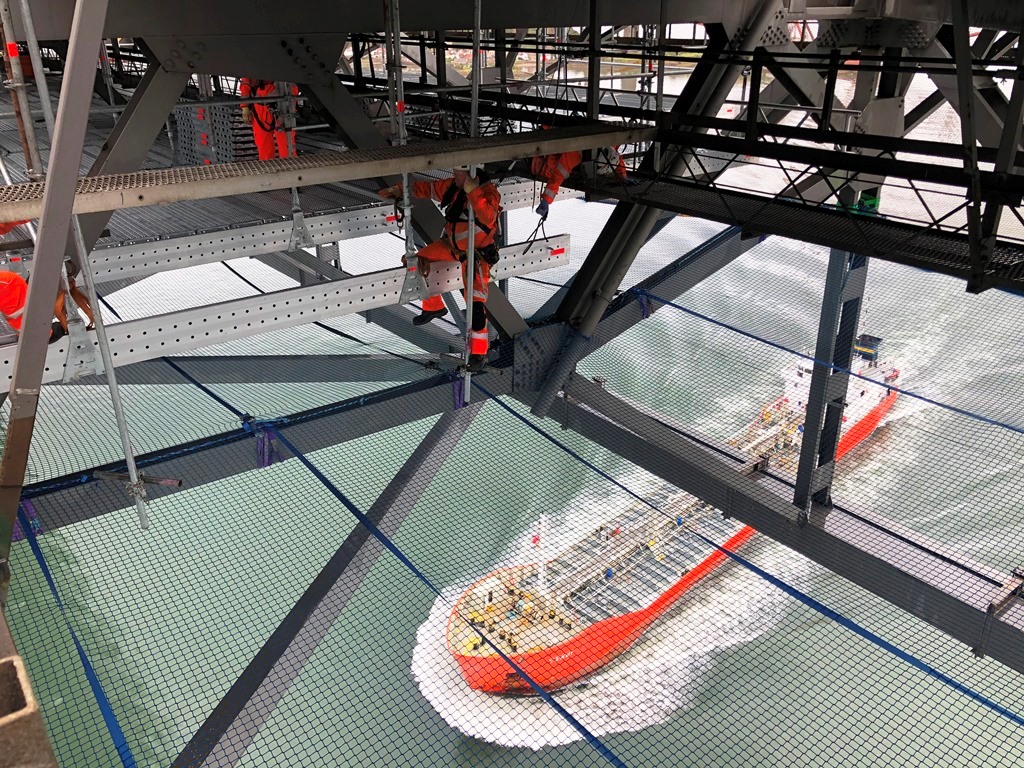
LAYHER has revealed that the company’s FlexBeam system is ‘central’ to major maintenance work being undertaken on the iconic Forth Road Bridge. The solution is helping to create an ‘extensive’ work area underneath the road deck of the bridge.
Ross Brown is director of I-Scaff Access Solutions Ltd, who have installed the system for main contractor Millar Callaghan Engineering Services Ltd – working for BEAR Scotland, appointed principal contractor by bridge owners, Transport Scotland. He highlighted key elements of the access project: “The underside of the bridge deck features a series of parallel walkways, totalling some 10 km in length, which were installed in the 1980’s to provide Suspended Span Underdeck Access (SSUDA) to help facilitate engineering, maintenance and inspection activities.
“These gantries are now undergoing their own programme of maintenance which has called for a full width suspended scaffold to be installed as a means of access. We have been brought in to meet this need on the sixth phase – some 120 metres in length across the full 36 metres width of the bridge – and our use of the Layher FlexBeam has brought major advantages to the work.”
Layher revealed the system has required ‘far less’ equipment than had been experienced in earlier phases where tube and fitting scaffold was used. This, the firm said, has created fewer obstructions.

“The walkways are being removed for offsite refurbishment before being returned to and refitted on the bridge to continue their SSUDA role for, it is anticipated, a further 25 years,” Ross Brown added. “With some sections measuring up to nine metres in length, the handling equipment is gaining significantly from the relatively unobstructed platform.”
He added that the standards from which the temporary decking is suspended are located at an average of 4.5 metre intervals rather than the 1.6 metres typically required by tube and fitting. “Overall, we have been able to install 80 square metres of suspended decking per day on average – twice as fast as was originally the case.”
The Layher installation features standards linked in clusters of three using wedge-head swivel couplers which, in turn, are clamped to, and suspended from, the bridge’s own steelwork using girder couplers. These standards then drop down to connect directly to the FlexBeams installed at up to 5.5 metre intervals, and onto which Layher’s Allround Lightweight steel decking is then located.
A choice of decking lengths has enabled I-Scaff to accommodate the diagonal steel sections that form part of the bridge structure, while longitudinal bracing is only required every fourth bay. Guardrails and edge protection have also been installed, where appropriate, while dropped object netting has been located under the full working area by another Millar Callaghan Engineering Services subcontractor to protect the waterway below.
“The fact that the design, which has been undertaken by Kenneth Redman, technical manager at our Livingston depot in Scotland, enables the scaffold to be suspended from the bridge’s own steel structure is extremely beneficial,” explained Sean Pike, Layher’s UK MD.
He added that by using the Layher Scaffold Information Modelling (SIM) software, a clear visual demonstration of the advantages of the FlexBeam system was available to the client in VR format, directly from the company’s LayPLAN CAD design model. “The lightweight material has also helped with manual handling procedures, while the greatly reduced number of components has not only played a key role in optimising installation efficiency, it has also made a significant contribution to minimising transport and storage needs,” he said.
To date, the largest suspended scaffold installed in the UK to use Layher’s FlexBeam, the Forth Road Bridge also represents I-Scaff’s first application of the equipment, with the contractor undertaking familiarisation training at the Livingston facility. “We are delighted to be able to demonstrate to our customer that the benefits and savings on paper were recreated, and sometimes exceeded, when brought to life,” Ross Brown added. “The fact that we have been able to show clear gains by comparing our approach to that used on the previous five phases to date has been extremely beneficial, and points us towards more extensive use of the Layher FlexBeam in the future.”








